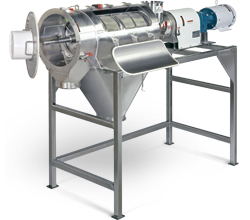|
 Kason's 3-A Dairy Accepted Centri-Sifter® centrifugal screener features a hinged end cover, self-securing screen cylinder and removable three-bearing cantilevered shaft/paddle/feed-screw assembly, allowing tool-free disassembly for rapid, thorough wash down. Kason's 3-A Dairy Accepted Centri-Sifter® centrifugal screener features a hinged end cover, self-securing screen cylinder and removable three-bearing cantilevered shaft/paddle/feed-screw assembly, allowing tool-free disassembly for rapid, thorough wash down.
External roller bearings are located at the motor end of the shaft and on a hinged cover at the discharge end for maximum support and vibration-free operation. When the end cover is hinged open, the shaft/paddle/feed-screw assembly becomes a cantilever supported by a third, externally mounted roller bearing located between the motor-end bearing and material feed point, allowing an operator to slide the screen cylinder and the entire shaft assembly from the machine.
Stainless steel rods projecting longitudinally from the downstream end of the screen cylinder flange press against the interior side of the hinged end cover when it is closed, locking the screen in place without the need for threaded studs and nuts, and allowing insertion and removal of screens in seconds.
Also specific to the 3-A design is a one-piece shaft/paddle/feed-screw assembly that is continuously welded, ground and polished, eliminating unsanitary crevices and threaded fasteners, and allowing rapid removal without tools.
The sifter is intended for food, dairy and pharmaceutical applications requiring thorough wash-down, as well as general chemical applications involving frequent screen changes/inspections or runs of multiple materials with no cross contamination.
Dry or moist bulk solid material is gravity-fed into the feed inlet and redirected into the cylindrical sifting chamber by means of a feed screw. Rotating helical paddles within the chamber continuously propel the material against the screen, while the resultant, centrifugal force on the particles accelerates them through the apertures. In addition to sifting and scalping of dry bulk materials, the screener can break-up soft agglomerates and/or dewater moist solids or slurries. Oversized particles and trash are propelled through the end of the screen cylinder into a discharge spout.
Options:
|

